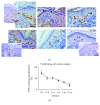Relation of Redox and Structural Alterations of Rat Skin in the Function of Chronological Aging
- PMID: 30906501
- PMCID: PMC6393874
- DOI: 10.1155/2019/2471312
Relation of Redox and Structural Alterations of Rat Skin in the Function of Chronological Aging
Abstract
Accumulation of oxidative insults on molecular and supramolecular levels could compromise renewal potency and architecture in the aging skin. To examine and compare morphological and ultrastructural changes with redox alterations during chronological skin aging, activities of antioxidant defense (AD) enzymes, superoxide dismutase (SOD), catalase (CAT), glutathione peroxidase (GSH-Px), glutathione reductase (GR), thioredoxin reductase (TR), and methionine sulfoxide reductase A (MsrA), and the markers of oxidative damage of biomolecules-4-hydroxynonenal (HNE) and 8-oxoguanine (8-oxoG)-were examined in the rat skin during life (from 3 days to 21 months). As compared to adult 3-month-old skin, higher activities of CAT, GSH-Px, and GR and a decline in expression of MsrA are found in 21-month-old skin. These changes correspond to degenerative changes at structural and ultrastructural levels in epidermal and dermal compartments, low proliferation capacity, and higher levels of HNE-modified protein aldehydes (particularly in basal lamina) and 8-oxoG positivity in nuclei and mitochondria in the sebaceous glands and root sheath. In 3-day-old skin, higher activities of AD enzymes (SOD, CAT, GR, and TR) and MsrA expression correspond to intensive postnatal development and proliferation. In contrast to 21-month-old skin, a high level of HNE in young skin is not accompanied by 8-oxoG positivity or any morphological disturbances. Observed results indicate that increased activity of AD enzymes in elderly rat skin represents the compensatory response to accumulated oxidative damage of DNA and proteins, accompanied by attenuated repair and proliferative capacity, but in young rats the redox changes are necessary and inherent with processes which occur during postnatal skin development. Мorphological and ultrastructurаl changes are in line with the redox profile in the skin of young and old rats.
Figures







Similar articles
-
Increased response to oxidative stress challenge in Graves' ophthalmopathy orbital fibroblasts.Mol Vis. 2011;17:2782-8. Epub 2011 Oct 26. Mol Vis. 2011. PMID: 22065933 Free PMC article.
-
Effect of selenium-enriched yeast pretreatment on the antioxidative defense in the skin of rats exposed to heat shock.J Environ Pathol Toxicol Oncol. 1998;17(3-4):305-11. J Environ Pathol Toxicol Oncol. 1998. PMID: 9726807
-
NiCl2-down-regulated antioxidant enzyme mRNA expression causes oxidative damage in the broiler(')s kidney.Biol Trace Elem Res. 2014 Dec;162(1-3):288-95. doi: 10.1007/s12011-014-0132-3. Epub 2014 Sep 25. Biol Trace Elem Res. 2014. PMID: 25253428
-
Rat testicular mitochondrial antioxidant defence system and its modulation by aging.Acta Biol Hung. 2008 Dec;59(4):413-24. doi: 10.1556/ABiol.59.2008.4.3. Acta Biol Hung. 2008. PMID: 19133498
-
The thioredoxin antioxidant system.Free Radic Biol Med. 2014 Jan;66:75-87. doi: 10.1016/j.freeradbiomed.2013.07.036. Epub 2013 Jul 27. Free Radic Biol Med. 2014. PMID: 23899494 Review.
Cited by
-
Selenium as a Bioactive Micronutrient in the Human Diet and Its Cancer Chemopreventive Activity.Nutrients. 2021 May 13;13(5):1649. doi: 10.3390/nu13051649. Nutrients. 2021. PMID: 34068374 Free PMC article. Review.
-
Tetrahydroxystilbene Glucoside Ameliorates Infrasound-Induced Central Nervous System (CNS) Injury by Improving Antioxidant and Anti-Inflammatory Capacity.Oxid Med Cell Longev. 2020 Jan 6;2020:6576718. doi: 10.1155/2020/6576718. eCollection 2020. Oxid Med Cell Longev. 2020. PMID: 31998440 Free PMC article.
-
Short-Term l-arginine Treatment Mitigates Early Damage of Dermal Collagen Induced by Diabetes.Bioengineering (Basel). 2024 Apr 21;11(4):407. doi: 10.3390/bioengineering11040407. Bioengineering (Basel). 2024. PMID: 38671828 Free PMC article.
-
Shedding a New Light on Skin Aging, Iron- and Redox-Homeostasis and Emerging Natural Antioxidants.Antioxidants (Basel). 2022 Feb 27;11(3):471. doi: 10.3390/antiox11030471. Antioxidants (Basel). 2022. PMID: 35326121 Free PMC article. Review.
-
Redox changes in obesity, metabolic syndrome, and diabetes.Redox Biol. 2021 Jun;42:101887. doi: 10.1016/j.redox.2021.101887. Epub 2021 Feb 4. Redox Biol. 2021. PMID: 33579666 Free PMC article. Review.
References
-
- Yoshimura H. Organ system in adaptation: the skin. In: Wilber C. G., editor. Handbook of Physiology. Washington, D.C.: American Physiological Society; 1963. pp. 109–133.
-
- Michelson A. M. Liposomal SOD and its application to skin diseases and other disorders. Japanese Journal of Dermatology. 1986;96:1376–1383.
MeSH terms
Substances
LinkOut - more resources
Full Text Sources
Medical
Research Materials
Miscellaneous

